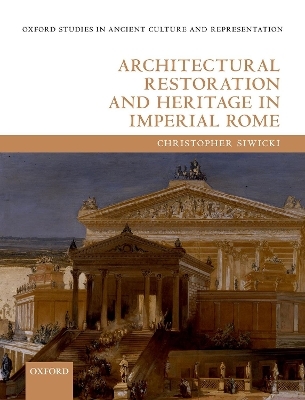
Architectural Restoration and Heritage in Imperial Rome
Oxford University Press (Verlag)
978-0-19-884857-8 (ISBN)
This volume addresses the treatment and perception of historic buildings in Imperial Rome, examining the ways in which public monuments were restored in order to develop an understanding of the Roman concept of built heritage. It considers examples from the first century BC to the second century AD, focusing primarily on the six decades between the Great Fire of AD 64 and the AD 120s, which constituted a period of dramatic urban transformation and architectural innovation in Rome. Through a detailed analysis of the ways in which the design, materiality, and appearance of buildings - including the temple of Jupiter Capitolinus and hut of Romulus - developed with successive restorations, the case is made for the existence of a consistent approach to the treatment of historic buildings in this period. This study also explores how changes to particular monuments and to the urban fabric as a whole were received by the people who experienced them first-hand, uncovering attitudes to built heritage in Roman society more widely. By examining descriptions of destruction and restoration in literature of the first and second centuries AD, including the works of Seneca the Younger, Pliny the Elder, Martial, Tacitus, and Plutarch, it forms a picture of the conflicting ways in which Rome's inhabitants responded to the redevelopment of their city. The results provide an alternative way of explaining key interventions in Rome's built environment and challenge the idea that heritage is a purely modern phenomenon.
Christopher Siwicki is an Honorary Research Fellow at the University of Exeter, having also held the Rome Fellowship at the British School at Rome and the Grete Sondheimer Fellowship at the Warburg Institute. His research revolves around Roman architecture, in particular, how the ancients themselves perceived, experienced, and thought about the buildings around them.
Frontmatter
List of Figures
List of Tables
List of Abbreviations
0: Introduction: Starting from an Unexpected Premise
1: Definitions and Parameters
Architectural history in ancient Rome
Scholarship on architectural restoration
Defining heritage
The building site that was Rome
The architectural spirit of the age
2: Restoration: Why, Who, How
No ruins in Rome
Agency in design
Patrons and architects
The role of emperors
Innovative restoration
Architectural continuity
3: The Restorations of the Temple of Jupiter Capitolinus
Part 1: Four temples
Uncertain plans: substructures and superstructures
Catulus' temple
Vespasian's temple
Domitian's temple
Part 2: Building on the same footprint
Architecture and religion
Haruspices and building
Vestinus' decision to assemble the haruspices
A historic building in a modern guise
4: The Casa Romuli Anomaly
The two homes of Romulus
The peculiar appearance of the casa Romuli
The casa Romuli and Augustan ideology
Huts as exempla
The wooden bridge over the Tiber
Conclusion
5: Ancient Responses to Restoration
Silent structures
Jupiter Capitolinus, the people's temple
Cicero on the Capitolium
Martial on the Capitolium
Architecture and morality
Plutarch on the Capitolium
Conclusion
6: Roman Thoughts on the Rebuilding of Rome
Seneca on the fires of Lyon and Rome
Martial's building site
Tacitus on the destruction of Rome
Irreplaceable losses
Shade and oppression in rebuilt Rome
A better city
Conclusion
7: Conclusion
Where next: a tentative idea?
Endmatter
Bibliography
Index
| Erscheinungsdatum | 21.02.2020 |
|---|---|
| Reihe/Serie | Oxford Studies in Ancient Culture Representation |
| Zusatzinfo | 65 black-and-white illustrations |
| Verlagsort | Oxford |
| Sprache | englisch |
| Maße | 193 x 247 mm |
| Gewicht | 906 g |
| Themenwelt | Geisteswissenschaften ► Archäologie |
| Geschichte ► Allgemeine Geschichte ► Vor- und Frühgeschichte | |
| Geschichte ► Allgemeine Geschichte ► Altertum / Antike | |
| Technik ► Architektur | |
| ISBN-10 | 0-19-884857-9 / 0198848579 |
| ISBN-13 | 978-0-19-884857-8 / 9780198848578 |
| Zustand | Neuware |
| Haben Sie eine Frage zum Produkt? |
aus dem Bereich


